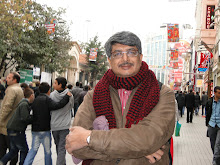Many blogs have waxed eloquent during the Domestic Violence Awareness month. These posts have been written with a lot of feeling and treat this serious problem with a lot of sensitivity and objectivity.
Instances of domestic violence can be gory and one can empathise with the victims living through hell every day of their life.
Activism and retaliation is widely advocated as a means of regaining some sanity in life and a means to lead, hopefully, a normal life. The moot question here is how many would actually take the desperate step of moving out. It may seem so very logical for a distant bystander but does this hold true for the victim and thereby hangs a tale of all silent sufferers.
This phenomenon that has assumed gigantic proportions in our modern day society (not just Indian but I can say for many countries around the world). Psychological counselling is touted as one possible solution but in reality and unfortunately this has very negative connotations here. Further, this sort of help is not easily accessible and it does not come cheap either.
Domestic violence should not be seen only in a physical dimension. It can be mental torture and emotional violence too. Many a time a sense of terror pervades the atmosphere along with physical violence. Unfortunately, violence finds an outlet only against our near-n-dear ones and those weaker than us.
If we look around carefully, there is plenty of repressed violence in us. We seem to be "Highly Inflammable" and ignite at the slightest provocation. Just a small divert - Have you seen the road rage that boils over in the event of a minor collision or the savagery displayed following some minor altercation in a Mumbai local train. Those who give in to such outbursts are not always the "poor" or "lower strata" as we pompously would like to say. They seem economically prosperous, well educated and seemingly very normal. Many others would just bottle up and bang the person who opens the door in the evening.
This build-up in us is the result of so many frustrations that we face in daily life, the stress that we generate and absorb, the struggle to be successful, the battle to survive, the violence that we absorb from sources "stronger" than us sometime for long years of our life and in many cases from childhood, the problems of addictions and its negative impact on family relationships.
This may seem over-simplified (believe me this is not a justification) but the fact is we keep on accumulating garbage over the years till an outlet is found. Usually, this outlet is in the form of violence and abuse in the safe confines of our own homes.
So, what is the solution and how do we go about spreading it on? Is there a standardised answer? Will public shame or punishment help or only aggravate? ........there are so many questions and I am afraid not many have a straight answer.
This is just looking at the perpetrator of violence. It is scary to think about the victims. The unending mystery is why do these victims continue to absorb their daily dose of abuse? I shudder as I try to imagine their life but just cannot fathom their compulsions.
I always believe that our education has only made us literates and never has it taught us about life and how to handle its many ups and downs. We have low EQs and are emotionally and spiritually bankrupt.
Till we are at peace within ourselves, no amount of external help or social activism can help. Social activism may stop one type of incidents but give rise to far more dangerous alternatives. Anything that is achieved out of compulsion or fear could ricochet back with deadly effect.
So what do we do????.....
Instances of domestic violence can be gory and one can empathise with the victims living through hell every day of their life.
Activism and retaliation is widely advocated as a means of regaining some sanity in life and a means to lead, hopefully, a normal life. The moot question here is how many would actually take the desperate step of moving out. It may seem so very logical for a distant bystander but does this hold true for the victim and thereby hangs a tale of all silent sufferers.
This phenomenon that has assumed gigantic proportions in our modern day society (not just Indian but I can say for many countries around the world). Psychological counselling is touted as one possible solution but in reality and unfortunately this has very negative connotations here. Further, this sort of help is not easily accessible and it does not come cheap either.
Domestic violence should not be seen only in a physical dimension. It can be mental torture and emotional violence too. Many a time a sense of terror pervades the atmosphere along with physical violence. Unfortunately, violence finds an outlet only against our near-n-dear ones and those weaker than us.
If we look around carefully, there is plenty of repressed violence in us. We seem to be "Highly Inflammable" and ignite at the slightest provocation. Just a small divert - Have you seen the road rage that boils over in the event of a minor collision or the savagery displayed following some minor altercation in a Mumbai local train. Those who give in to such outbursts are not always the "poor" or "lower strata" as we pompously would like to say. They seem economically prosperous, well educated and seemingly very normal. Many others would just bottle up and bang the person who opens the door in the evening.
This build-up in us is the result of so many frustrations that we face in daily life, the stress that we generate and absorb, the struggle to be successful, the battle to survive, the violence that we absorb from sources "stronger" than us sometime for long years of our life and in many cases from childhood, the problems of addictions and its negative impact on family relationships.
This may seem over-simplified (believe me this is not a justification) but the fact is we keep on accumulating garbage over the years till an outlet is found. Usually, this outlet is in the form of violence and abuse in the safe confines of our own homes.
So, what is the solution and how do we go about spreading it on? Is there a standardised answer? Will public shame or punishment help or only aggravate? ........there are so many questions and I am afraid not many have a straight answer.
This is just looking at the perpetrator of violence. It is scary to think about the victims. The unending mystery is why do these victims continue to absorb their daily dose of abuse? I shudder as I try to imagine their life but just cannot fathom their compulsions.
I always believe that our education has only made us literates and never has it taught us about life and how to handle its many ups and downs. We have low EQs and are emotionally and spiritually bankrupt.
Till we are at peace within ourselves, no amount of external help or social activism can help. Social activism may stop one type of incidents but give rise to far more dangerous alternatives. Anything that is achieved out of compulsion or fear could ricochet back with deadly effect.
So what do we do????.....
































































